University Investment Management: Active and Passive Portfolio Project
VerifiedAdded on 2020/05/16
|16
|3158
|27
Project
AI Summary
This project undertakes a comprehensive analysis of investment management strategies, focusing on both active and passive portfolio approaches. It begins by outlining relevant strategies for active portfolio management, including value screening and market timing, and discusses their application in constructing an effective investment plan. The project then presents a detailed comparison of the returns generated by active and passive portfolios over a specified period, using weighted returns to evaluate performance. The analysis includes a tabular presentation of annual returns for various stocks in the active portfolio, along with the portfolio's net return, and a similar presentation for the passive portfolio, incorporating SRI index and bond data. The project concludes with a theoretical analysis, discussing the implications of the findings and relating them to market hypothesis, highlighting the importance of selecting appropriate investment strategies. The findings indicate a decrease in the portfolio value for both active and passive investments, with a more significant reduction in the passive portfolio, suggesting a need for careful strategy selection and risk management.
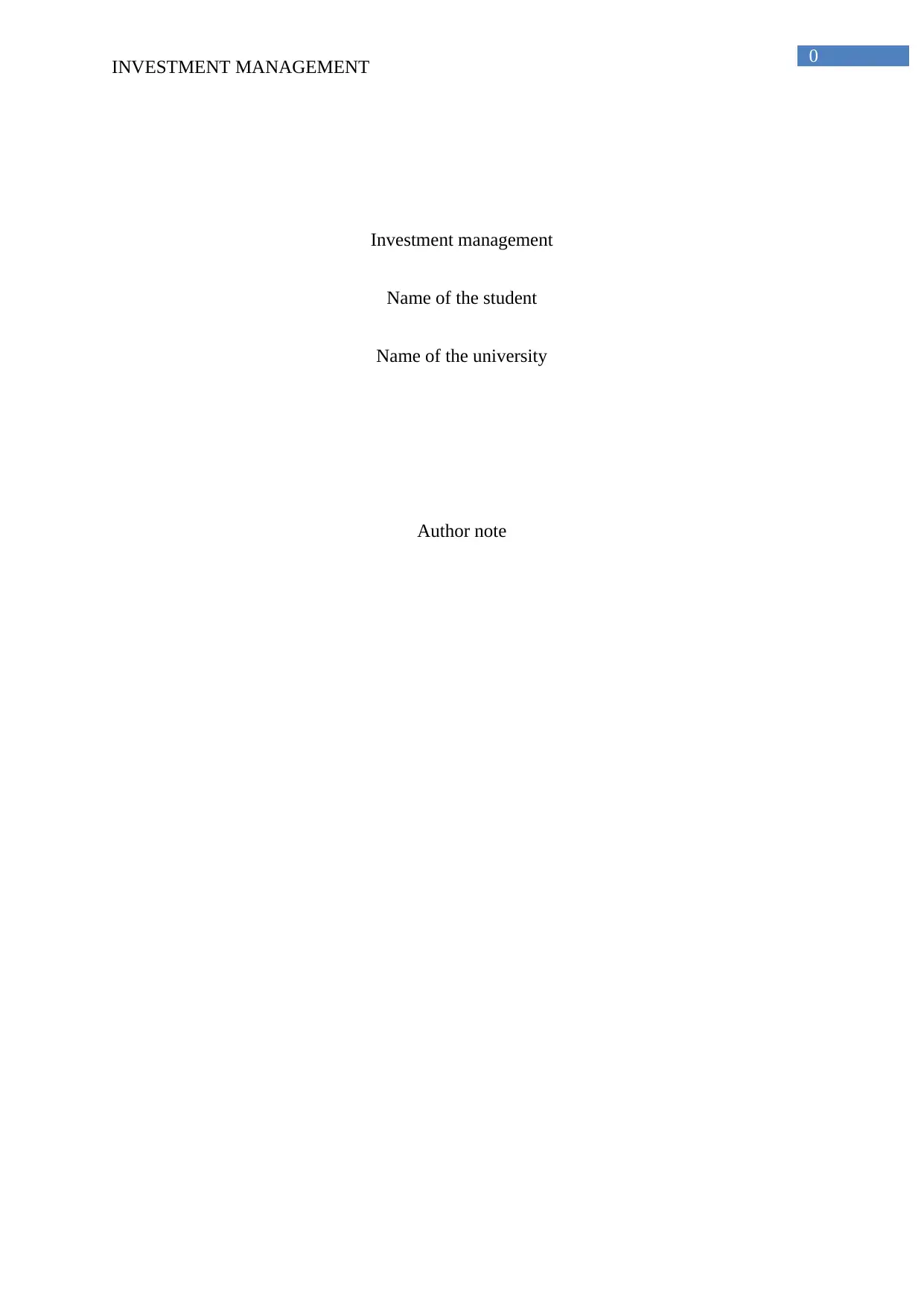
0
INVESTMENT MANAGEMENT
Investment management
Name of the student
Name of the university
Author note
INVESTMENT MANAGEMENT
Investment management
Name of the student
Name of the university
Author note
Paraphrase This Document
Need a fresh take? Get an instant paraphrase of this document with our AI Paraphraser
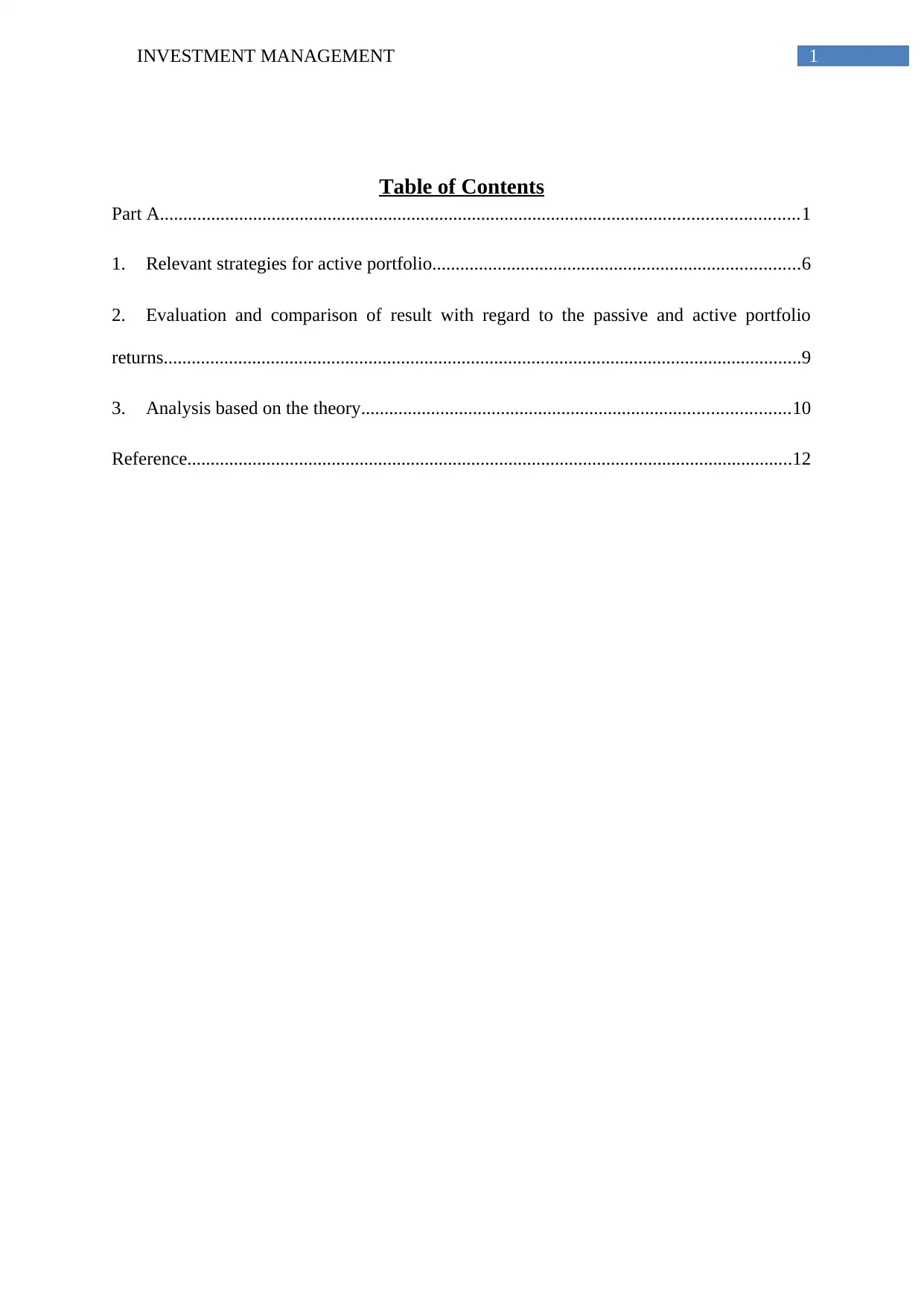
1INVESTMENT MANAGEMENT
Table of Contents
Part A.........................................................................................................................................1
1. Relevant strategies for active portfolio...............................................................................6
2. Evaluation and comparison of result with regard to the passive and active portfolio
returns.........................................................................................................................................9
3. Analysis based on the theory............................................................................................10
Reference..................................................................................................................................12
Table of Contents
Part A.........................................................................................................................................1
1. Relevant strategies for active portfolio...............................................................................6
2. Evaluation and comparison of result with regard to the passive and active portfolio
returns.........................................................................................................................................9
3. Analysis based on the theory............................................................................................10
Reference..................................................................................................................................12
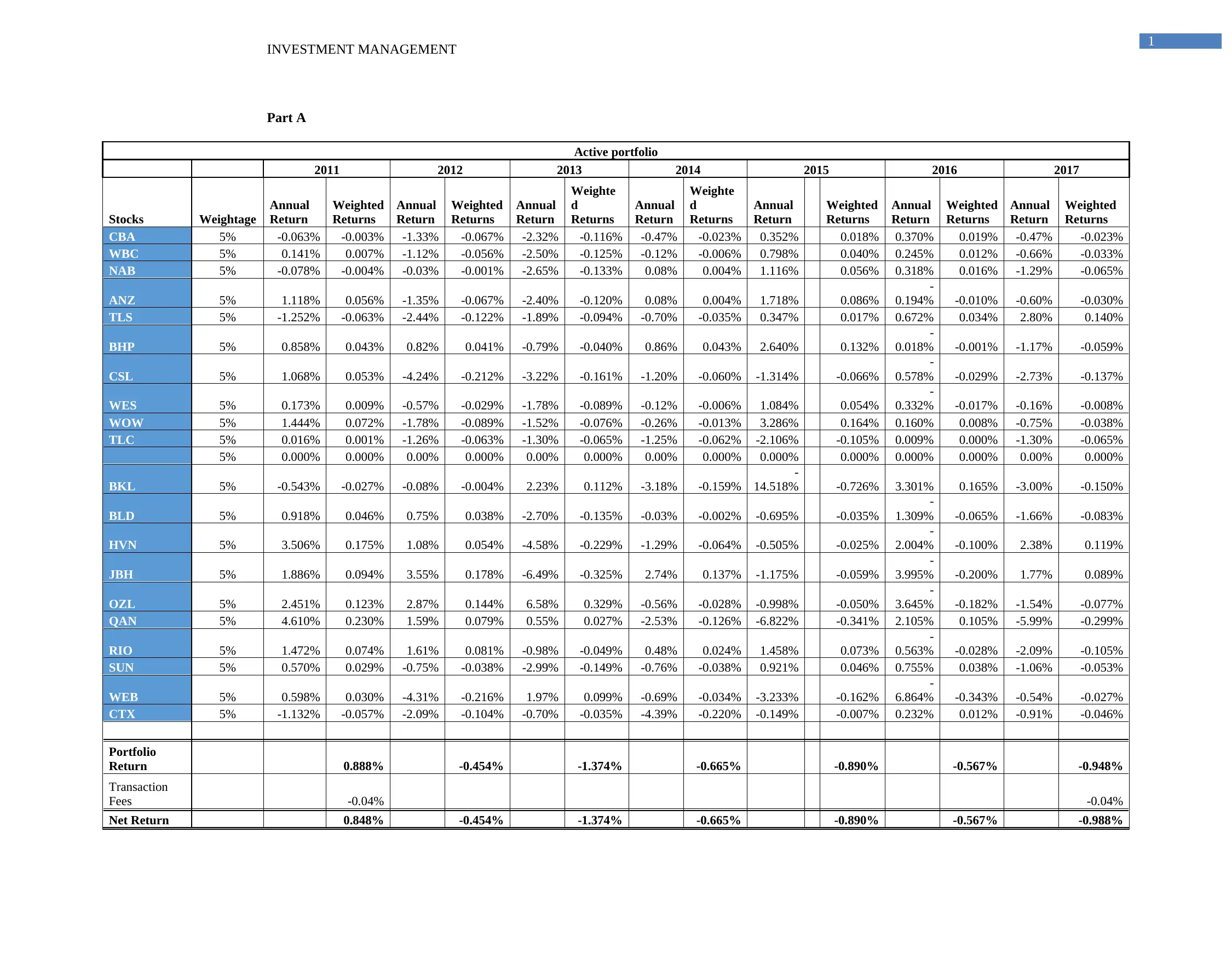
1
INVESTMENT MANAGEMENT
Part A
Active portfolio
2011 2012 2013 2014 2015 2016 2017
Stocks Weightage
Annual
Return
Weighted
Returns
Annual
Return
Weighted
Returns
Annual
Return
Weighte
d
Returns
Annual
Return
Weighte
d
Returns
Annual
Return
Weighted
Returns
Annual
Return
Weighted
Returns
Annual
Return
Weighted
Returns
CBA 5% -0.063% -0.003% -1.33% -0.067% -2.32% -0.116% -0.47% -0.023% 0.352% 0.018% 0.370% 0.019% -0.47% -0.023%
WBC 5% 0.141% 0.007% -1.12% -0.056% -2.50% -0.125% -0.12% -0.006% 0.798% 0.040% 0.245% 0.012% -0.66% -0.033%
NAB 5% -0.078% -0.004% -0.03% -0.001% -2.65% -0.133% 0.08% 0.004% 1.116% 0.056% 0.318% 0.016% -1.29% -0.065%
ANZ 5% 1.118% 0.056% -1.35% -0.067% -2.40% -0.120% 0.08% 0.004% 1.718% 0.086%
-
0.194% -0.010% -0.60% -0.030%
TLS 5% -1.252% -0.063% -2.44% -0.122% -1.89% -0.094% -0.70% -0.035% 0.347% 0.017% 0.672% 0.034% 2.80% 0.140%
BHP 5% 0.858% 0.043% 0.82% 0.041% -0.79% -0.040% 0.86% 0.043% 2.640% 0.132%
-
0.018% -0.001% -1.17% -0.059%
CSL 5% 1.068% 0.053% -4.24% -0.212% -3.22% -0.161% -1.20% -0.060% -1.314% -0.066%
-
0.578% -0.029% -2.73% -0.137%
WES 5% 0.173% 0.009% -0.57% -0.029% -1.78% -0.089% -0.12% -0.006% 1.084% 0.054%
-
0.332% -0.017% -0.16% -0.008%
WOW 5% 1.444% 0.072% -1.78% -0.089% -1.52% -0.076% -0.26% -0.013% 3.286% 0.164% 0.160% 0.008% -0.75% -0.038%
TLC 5% 0.016% 0.001% -1.26% -0.063% -1.30% -0.065% -1.25% -0.062% -2.106% -0.105% 0.009% 0.000% -1.30% -0.065%
5% 0.000% 0.000% 0.00% 0.000% 0.00% 0.000% 0.00% 0.000% 0.000% 0.000% 0.000% 0.000% 0.00% 0.000%
BKL 5% -0.543% -0.027% -0.08% -0.004% 2.23% 0.112% -3.18% -0.159%
-
14.518% -0.726% 3.301% 0.165% -3.00% -0.150%
BLD 5% 0.918% 0.046% 0.75% 0.038% -2.70% -0.135% -0.03% -0.002% -0.695% -0.035%
-
1.309% -0.065% -1.66% -0.083%
HVN 5% 3.506% 0.175% 1.08% 0.054% -4.58% -0.229% -1.29% -0.064% -0.505% -0.025%
-
2.004% -0.100% 2.38% 0.119%
JBH 5% 1.886% 0.094% 3.55% 0.178% -6.49% -0.325% 2.74% 0.137% -1.175% -0.059%
-
3.995% -0.200% 1.77% 0.089%
OZL 5% 2.451% 0.123% 2.87% 0.144% 6.58% 0.329% -0.56% -0.028% -0.998% -0.050%
-
3.645% -0.182% -1.54% -0.077%
QAN 5% 4.610% 0.230% 1.59% 0.079% 0.55% 0.027% -2.53% -0.126% -6.822% -0.341% 2.105% 0.105% -5.99% -0.299%
RIO 5% 1.472% 0.074% 1.61% 0.081% -0.98% -0.049% 0.48% 0.024% 1.458% 0.073%
-
0.563% -0.028% -2.09% -0.105%
SUN 5% 0.570% 0.029% -0.75% -0.038% -2.99% -0.149% -0.76% -0.038% 0.921% 0.046% 0.755% 0.038% -1.06% -0.053%
WEB 5% 0.598% 0.030% -4.31% -0.216% 1.97% 0.099% -0.69% -0.034% -3.233% -0.162%
-
6.864% -0.343% -0.54% -0.027%
CTX 5% -1.132% -0.057% -2.09% -0.104% -0.70% -0.035% -4.39% -0.220% -0.149% -0.007% 0.232% 0.012% -0.91% -0.046%
Portfolio
Return 0.888% -0.454% -1.374% -0.665% -0.890% -0.567% -0.948%
Transaction
Fees -0.04% -0.04%
Net Return 0.848% -0.454% -1.374% -0.665% -0.890% -0.567% -0.988%
INVESTMENT MANAGEMENT
Part A
Active portfolio
2011 2012 2013 2014 2015 2016 2017
Stocks Weightage
Annual
Return
Weighted
Returns
Annual
Return
Weighted
Returns
Annual
Return
Weighte
d
Returns
Annual
Return
Weighte
d
Returns
Annual
Return
Weighted
Returns
Annual
Return
Weighted
Returns
Annual
Return
Weighted
Returns
CBA 5% -0.063% -0.003% -1.33% -0.067% -2.32% -0.116% -0.47% -0.023% 0.352% 0.018% 0.370% 0.019% -0.47% -0.023%
WBC 5% 0.141% 0.007% -1.12% -0.056% -2.50% -0.125% -0.12% -0.006% 0.798% 0.040% 0.245% 0.012% -0.66% -0.033%
NAB 5% -0.078% -0.004% -0.03% -0.001% -2.65% -0.133% 0.08% 0.004% 1.116% 0.056% 0.318% 0.016% -1.29% -0.065%
ANZ 5% 1.118% 0.056% -1.35% -0.067% -2.40% -0.120% 0.08% 0.004% 1.718% 0.086%
-
0.194% -0.010% -0.60% -0.030%
TLS 5% -1.252% -0.063% -2.44% -0.122% -1.89% -0.094% -0.70% -0.035% 0.347% 0.017% 0.672% 0.034% 2.80% 0.140%
BHP 5% 0.858% 0.043% 0.82% 0.041% -0.79% -0.040% 0.86% 0.043% 2.640% 0.132%
-
0.018% -0.001% -1.17% -0.059%
CSL 5% 1.068% 0.053% -4.24% -0.212% -3.22% -0.161% -1.20% -0.060% -1.314% -0.066%
-
0.578% -0.029% -2.73% -0.137%
WES 5% 0.173% 0.009% -0.57% -0.029% -1.78% -0.089% -0.12% -0.006% 1.084% 0.054%
-
0.332% -0.017% -0.16% -0.008%
WOW 5% 1.444% 0.072% -1.78% -0.089% -1.52% -0.076% -0.26% -0.013% 3.286% 0.164% 0.160% 0.008% -0.75% -0.038%
TLC 5% 0.016% 0.001% -1.26% -0.063% -1.30% -0.065% -1.25% -0.062% -2.106% -0.105% 0.009% 0.000% -1.30% -0.065%
5% 0.000% 0.000% 0.00% 0.000% 0.00% 0.000% 0.00% 0.000% 0.000% 0.000% 0.000% 0.000% 0.00% 0.000%
BKL 5% -0.543% -0.027% -0.08% -0.004% 2.23% 0.112% -3.18% -0.159%
-
14.518% -0.726% 3.301% 0.165% -3.00% -0.150%
BLD 5% 0.918% 0.046% 0.75% 0.038% -2.70% -0.135% -0.03% -0.002% -0.695% -0.035%
-
1.309% -0.065% -1.66% -0.083%
HVN 5% 3.506% 0.175% 1.08% 0.054% -4.58% -0.229% -1.29% -0.064% -0.505% -0.025%
-
2.004% -0.100% 2.38% 0.119%
JBH 5% 1.886% 0.094% 3.55% 0.178% -6.49% -0.325% 2.74% 0.137% -1.175% -0.059%
-
3.995% -0.200% 1.77% 0.089%
OZL 5% 2.451% 0.123% 2.87% 0.144% 6.58% 0.329% -0.56% -0.028% -0.998% -0.050%
-
3.645% -0.182% -1.54% -0.077%
QAN 5% 4.610% 0.230% 1.59% 0.079% 0.55% 0.027% -2.53% -0.126% -6.822% -0.341% 2.105% 0.105% -5.99% -0.299%
RIO 5% 1.472% 0.074% 1.61% 0.081% -0.98% -0.049% 0.48% 0.024% 1.458% 0.073%
-
0.563% -0.028% -2.09% -0.105%
SUN 5% 0.570% 0.029% -0.75% -0.038% -2.99% -0.149% -0.76% -0.038% 0.921% 0.046% 0.755% 0.038% -1.06% -0.053%
WEB 5% 0.598% 0.030% -4.31% -0.216% 1.97% 0.099% -0.69% -0.034% -3.233% -0.162%
-
6.864% -0.343% -0.54% -0.027%
CTX 5% -1.132% -0.057% -2.09% -0.104% -0.70% -0.035% -4.39% -0.220% -0.149% -0.007% 0.232% 0.012% -0.91% -0.046%
Portfolio
Return 0.888% -0.454% -1.374% -0.665% -0.890% -0.567% -0.948%
Transaction
Fees -0.04% -0.04%
Net Return 0.848% -0.454% -1.374% -0.665% -0.890% -0.567% -0.988%
⊘ This is a preview!⊘
Do you want full access?
Subscribe today to unlock all pages.

Trusted by 1+ million students worldwide
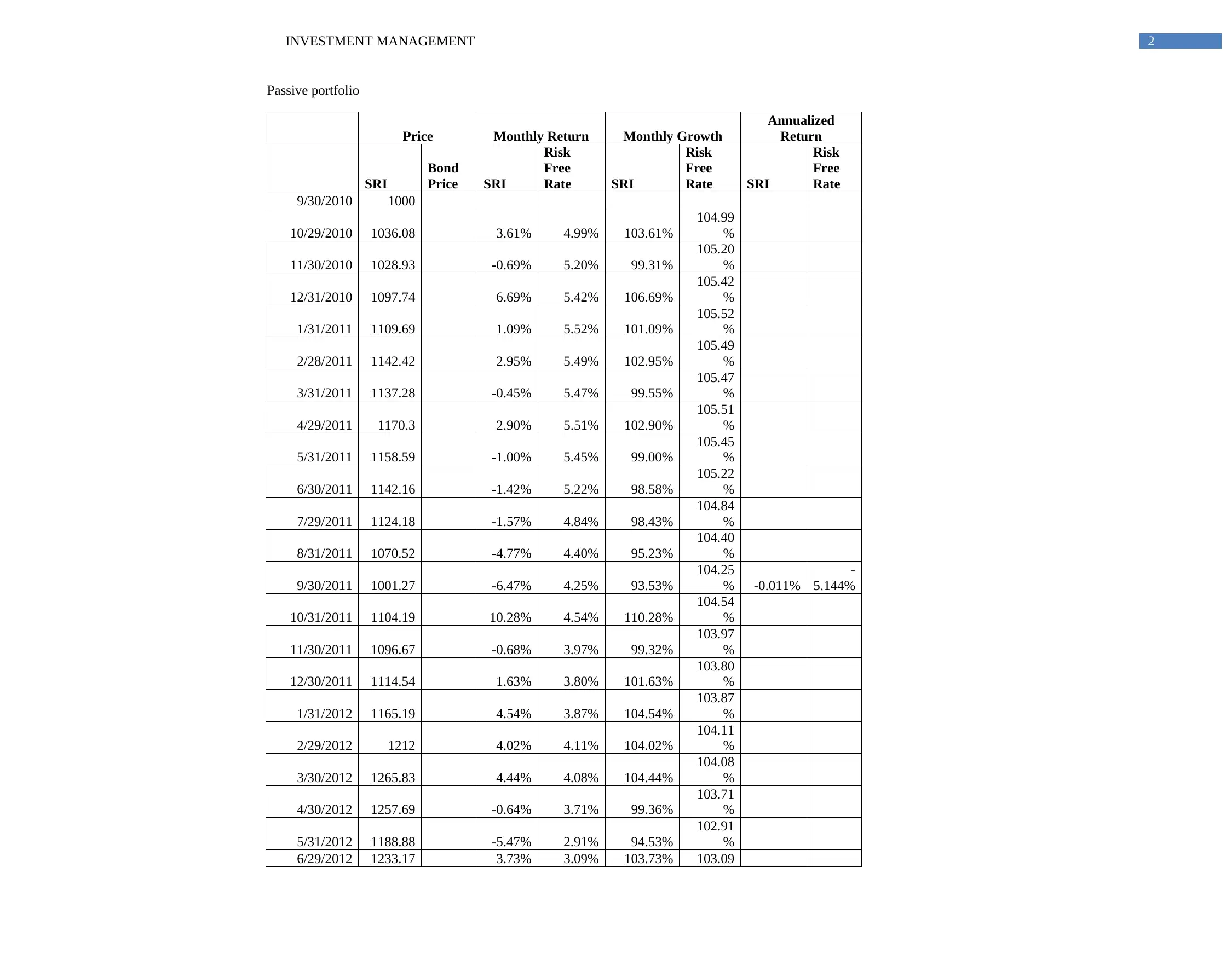
2INVESTMENT MANAGEMENT
Passive portfolio
Price Monthly Return Monthly Growth
Annualized
Return
SRI
Bond
Price SRI
Risk
Free
Rate SRI
Risk
Free
Rate SRI
Risk
Free
Rate
9/30/2010 1000
10/29/2010 1036.08 3.61% 4.99% 103.61%
104.99
%
11/30/2010 1028.93 -0.69% 5.20% 99.31%
105.20
%
12/31/2010 1097.74 6.69% 5.42% 106.69%
105.42
%
1/31/2011 1109.69 1.09% 5.52% 101.09%
105.52
%
2/28/2011 1142.42 2.95% 5.49% 102.95%
105.49
%
3/31/2011 1137.28 -0.45% 5.47% 99.55%
105.47
%
4/29/2011 1170.3 2.90% 5.51% 102.90%
105.51
%
5/31/2011 1158.59 -1.00% 5.45% 99.00%
105.45
%
6/30/2011 1142.16 -1.42% 5.22% 98.58%
105.22
%
7/29/2011 1124.18 -1.57% 4.84% 98.43%
104.84
%
8/31/2011 1070.52 -4.77% 4.40% 95.23%
104.40
%
9/30/2011 1001.27 -6.47% 4.25% 93.53%
104.25
% -0.011%
-
5.144%
10/31/2011 1104.19 10.28% 4.54% 110.28%
104.54
%
11/30/2011 1096.67 -0.68% 3.97% 99.32%
103.97
%
12/30/2011 1114.54 1.63% 3.80% 101.63%
103.80
%
1/31/2012 1165.19 4.54% 3.87% 104.54%
103.87
%
2/29/2012 1212 4.02% 4.11% 104.02%
104.11
%
3/30/2012 1265.83 4.44% 4.08% 104.44%
104.08
%
4/30/2012 1257.69 -0.64% 3.71% 99.36%
103.71
%
5/31/2012 1188.88 -5.47% 2.91% 94.53%
102.91
%
6/29/2012 1233.17 3.73% 3.09% 103.73% 103.09
Passive portfolio
Price Monthly Return Monthly Growth
Annualized
Return
SRI
Bond
Price SRI
Risk
Free
Rate SRI
Risk
Free
Rate SRI
Risk
Free
Rate
9/30/2010 1000
10/29/2010 1036.08 3.61% 4.99% 103.61%
104.99
%
11/30/2010 1028.93 -0.69% 5.20% 99.31%
105.20
%
12/31/2010 1097.74 6.69% 5.42% 106.69%
105.42
%
1/31/2011 1109.69 1.09% 5.52% 101.09%
105.52
%
2/28/2011 1142.42 2.95% 5.49% 102.95%
105.49
%
3/31/2011 1137.28 -0.45% 5.47% 99.55%
105.47
%
4/29/2011 1170.3 2.90% 5.51% 102.90%
105.51
%
5/31/2011 1158.59 -1.00% 5.45% 99.00%
105.45
%
6/30/2011 1142.16 -1.42% 5.22% 98.58%
105.22
%
7/29/2011 1124.18 -1.57% 4.84% 98.43%
104.84
%
8/31/2011 1070.52 -4.77% 4.40% 95.23%
104.40
%
9/30/2011 1001.27 -6.47% 4.25% 93.53%
104.25
% -0.011%
-
5.144%
10/31/2011 1104.19 10.28% 4.54% 110.28%
104.54
%
11/30/2011 1096.67 -0.68% 3.97% 99.32%
103.97
%
12/30/2011 1114.54 1.63% 3.80% 101.63%
103.80
%
1/31/2012 1165.19 4.54% 3.87% 104.54%
103.87
%
2/29/2012 1212 4.02% 4.11% 104.02%
104.11
%
3/30/2012 1265.83 4.44% 4.08% 104.44%
104.08
%
4/30/2012 1257.69 -0.64% 3.71% 99.36%
103.71
%
5/31/2012 1188.88 -5.47% 2.91% 94.53%
102.91
%
6/29/2012 1233.17 3.73% 3.09% 103.73% 103.09
Paraphrase This Document
Need a fresh take? Get an instant paraphrase of this document with our AI Paraphraser
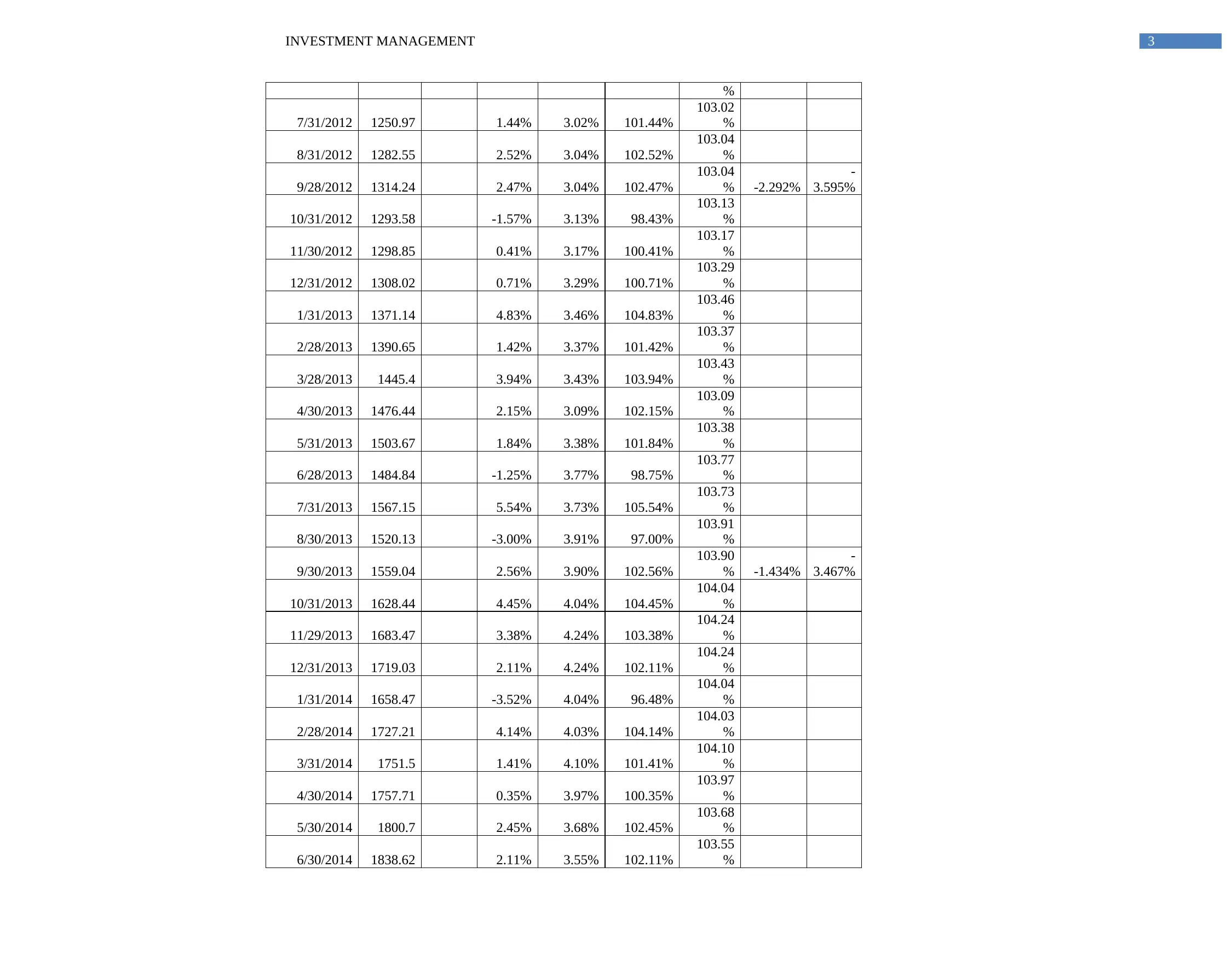
3INVESTMENT MANAGEMENT
%
7/31/2012 1250.97 1.44% 3.02% 101.44%
103.02
%
8/31/2012 1282.55 2.52% 3.04% 102.52%
103.04
%
9/28/2012 1314.24 2.47% 3.04% 102.47%
103.04
% -2.292%
-
3.595%
10/31/2012 1293.58 -1.57% 3.13% 98.43%
103.13
%
11/30/2012 1298.85 0.41% 3.17% 100.41%
103.17
%
12/31/2012 1308.02 0.71% 3.29% 100.71%
103.29
%
1/31/2013 1371.14 4.83% 3.46% 104.83%
103.46
%
2/28/2013 1390.65 1.42% 3.37% 101.42%
103.37
%
3/28/2013 1445.4 3.94% 3.43% 103.94%
103.43
%
4/30/2013 1476.44 2.15% 3.09% 102.15%
103.09
%
5/31/2013 1503.67 1.84% 3.38% 101.84%
103.38
%
6/28/2013 1484.84 -1.25% 3.77% 98.75%
103.77
%
7/31/2013 1567.15 5.54% 3.73% 105.54%
103.73
%
8/30/2013 1520.13 -3.00% 3.91% 97.00%
103.91
%
9/30/2013 1559.04 2.56% 3.90% 102.56%
103.90
% -1.434%
-
3.467%
10/31/2013 1628.44 4.45% 4.04% 104.45%
104.04
%
11/29/2013 1683.47 3.38% 4.24% 103.38%
104.24
%
12/31/2013 1719.03 2.11% 4.24% 102.11%
104.24
%
1/31/2014 1658.47 -3.52% 4.04% 96.48%
104.04
%
2/28/2014 1727.21 4.14% 4.03% 104.14%
104.03
%
3/31/2014 1751.5 1.41% 4.10% 101.41%
104.10
%
4/30/2014 1757.71 0.35% 3.97% 100.35%
103.97
%
5/30/2014 1800.7 2.45% 3.68% 102.45%
103.68
%
6/30/2014 1838.62 2.11% 3.55% 102.11%
103.55
%
%
7/31/2012 1250.97 1.44% 3.02% 101.44%
103.02
%
8/31/2012 1282.55 2.52% 3.04% 102.52%
103.04
%
9/28/2012 1314.24 2.47% 3.04% 102.47%
103.04
% -2.292%
-
3.595%
10/31/2012 1293.58 -1.57% 3.13% 98.43%
103.13
%
11/30/2012 1298.85 0.41% 3.17% 100.41%
103.17
%
12/31/2012 1308.02 0.71% 3.29% 100.71%
103.29
%
1/31/2013 1371.14 4.83% 3.46% 104.83%
103.46
%
2/28/2013 1390.65 1.42% 3.37% 101.42%
103.37
%
3/28/2013 1445.4 3.94% 3.43% 103.94%
103.43
%
4/30/2013 1476.44 2.15% 3.09% 102.15%
103.09
%
5/31/2013 1503.67 1.84% 3.38% 101.84%
103.38
%
6/28/2013 1484.84 -1.25% 3.77% 98.75%
103.77
%
7/31/2013 1567.15 5.54% 3.73% 105.54%
103.73
%
8/30/2013 1520.13 -3.00% 3.91% 97.00%
103.91
%
9/30/2013 1559.04 2.56% 3.90% 102.56%
103.90
% -1.434%
-
3.467%
10/31/2013 1628.44 4.45% 4.04% 104.45%
104.04
%
11/29/2013 1683.47 3.38% 4.24% 103.38%
104.24
%
12/31/2013 1719.03 2.11% 4.24% 102.11%
104.24
%
1/31/2014 1658.47 -3.52% 4.04% 96.48%
104.04
%
2/28/2014 1727.21 4.14% 4.03% 104.14%
104.03
%
3/31/2014 1751.5 1.41% 4.10% 101.41%
104.10
%
4/30/2014 1757.71 0.35% 3.97% 100.35%
103.97
%
5/30/2014 1800.7 2.45% 3.68% 102.45%
103.68
%
6/30/2014 1838.62 2.11% 3.55% 102.11%
103.55
%
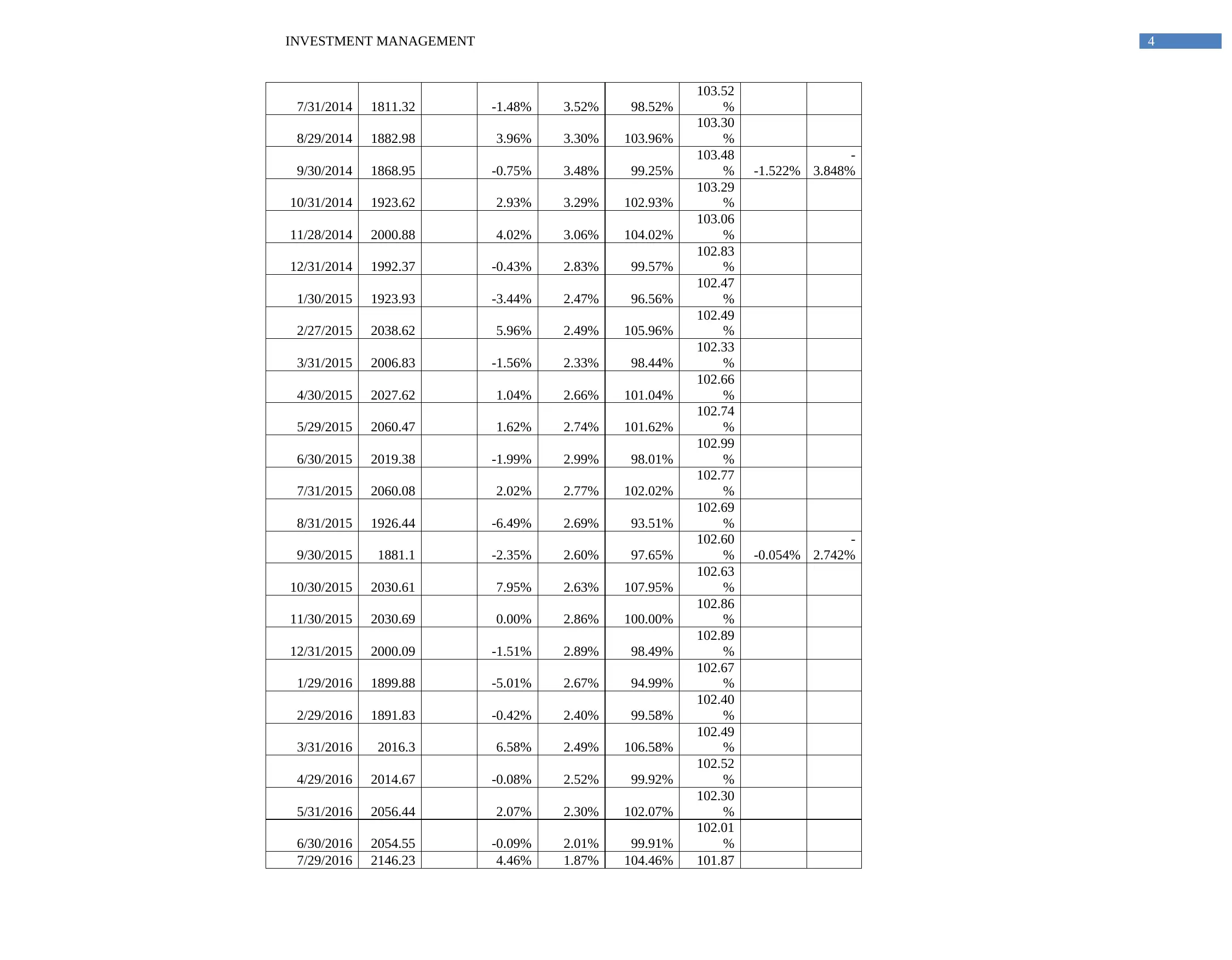
4INVESTMENT MANAGEMENT
7/31/2014 1811.32 -1.48% 3.52% 98.52%
103.52
%
8/29/2014 1882.98 3.96% 3.30% 103.96%
103.30
%
9/30/2014 1868.95 -0.75% 3.48% 99.25%
103.48
% -1.522%
-
3.848%
10/31/2014 1923.62 2.93% 3.29% 102.93%
103.29
%
11/28/2014 2000.88 4.02% 3.06% 104.02%
103.06
%
12/31/2014 1992.37 -0.43% 2.83% 99.57%
102.83
%
1/30/2015 1923.93 -3.44% 2.47% 96.56%
102.47
%
2/27/2015 2038.62 5.96% 2.49% 105.96%
102.49
%
3/31/2015 2006.83 -1.56% 2.33% 98.44%
102.33
%
4/30/2015 2027.62 1.04% 2.66% 101.04%
102.66
%
5/29/2015 2060.47 1.62% 2.74% 101.62%
102.74
%
6/30/2015 2019.38 -1.99% 2.99% 98.01%
102.99
%
7/31/2015 2060.08 2.02% 2.77% 102.02%
102.77
%
8/31/2015 1926.44 -6.49% 2.69% 93.51%
102.69
%
9/30/2015 1881.1 -2.35% 2.60% 97.65%
102.60
% -0.054%
-
2.742%
10/30/2015 2030.61 7.95% 2.63% 107.95%
102.63
%
11/30/2015 2030.69 0.00% 2.86% 100.00%
102.86
%
12/31/2015 2000.09 -1.51% 2.89% 98.49%
102.89
%
1/29/2016 1899.88 -5.01% 2.67% 94.99%
102.67
%
2/29/2016 1891.83 -0.42% 2.40% 99.58%
102.40
%
3/31/2016 2016.3 6.58% 2.49% 106.58%
102.49
%
4/29/2016 2014.67 -0.08% 2.52% 99.92%
102.52
%
5/31/2016 2056.44 2.07% 2.30% 102.07%
102.30
%
6/30/2016 2054.55 -0.09% 2.01% 99.91%
102.01
%
7/29/2016 2146.23 4.46% 1.87% 104.46% 101.87
7/31/2014 1811.32 -1.48% 3.52% 98.52%
103.52
%
8/29/2014 1882.98 3.96% 3.30% 103.96%
103.30
%
9/30/2014 1868.95 -0.75% 3.48% 99.25%
103.48
% -1.522%
-
3.848%
10/31/2014 1923.62 2.93% 3.29% 102.93%
103.29
%
11/28/2014 2000.88 4.02% 3.06% 104.02%
103.06
%
12/31/2014 1992.37 -0.43% 2.83% 99.57%
102.83
%
1/30/2015 1923.93 -3.44% 2.47% 96.56%
102.47
%
2/27/2015 2038.62 5.96% 2.49% 105.96%
102.49
%
3/31/2015 2006.83 -1.56% 2.33% 98.44%
102.33
%
4/30/2015 2027.62 1.04% 2.66% 101.04%
102.66
%
5/29/2015 2060.47 1.62% 2.74% 101.62%
102.74
%
6/30/2015 2019.38 -1.99% 2.99% 98.01%
102.99
%
7/31/2015 2060.08 2.02% 2.77% 102.02%
102.77
%
8/31/2015 1926.44 -6.49% 2.69% 93.51%
102.69
%
9/30/2015 1881.1 -2.35% 2.60% 97.65%
102.60
% -0.054%
-
2.742%
10/30/2015 2030.61 7.95% 2.63% 107.95%
102.63
%
11/30/2015 2030.69 0.00% 2.86% 100.00%
102.86
%
12/31/2015 2000.09 -1.51% 2.89% 98.49%
102.89
%
1/29/2016 1899.88 -5.01% 2.67% 94.99%
102.67
%
2/29/2016 1891.83 -0.42% 2.40% 99.58%
102.40
%
3/31/2016 2016.3 6.58% 2.49% 106.58%
102.49
%
4/29/2016 2014.67 -0.08% 2.52% 99.92%
102.52
%
5/31/2016 2056.44 2.07% 2.30% 102.07%
102.30
%
6/30/2016 2054.55 -0.09% 2.01% 99.91%
102.01
%
7/29/2016 2146.23 4.46% 1.87% 104.46% 101.87
⊘ This is a preview!⊘
Do you want full access?
Subscribe today to unlock all pages.

Trusted by 1+ million students worldwide
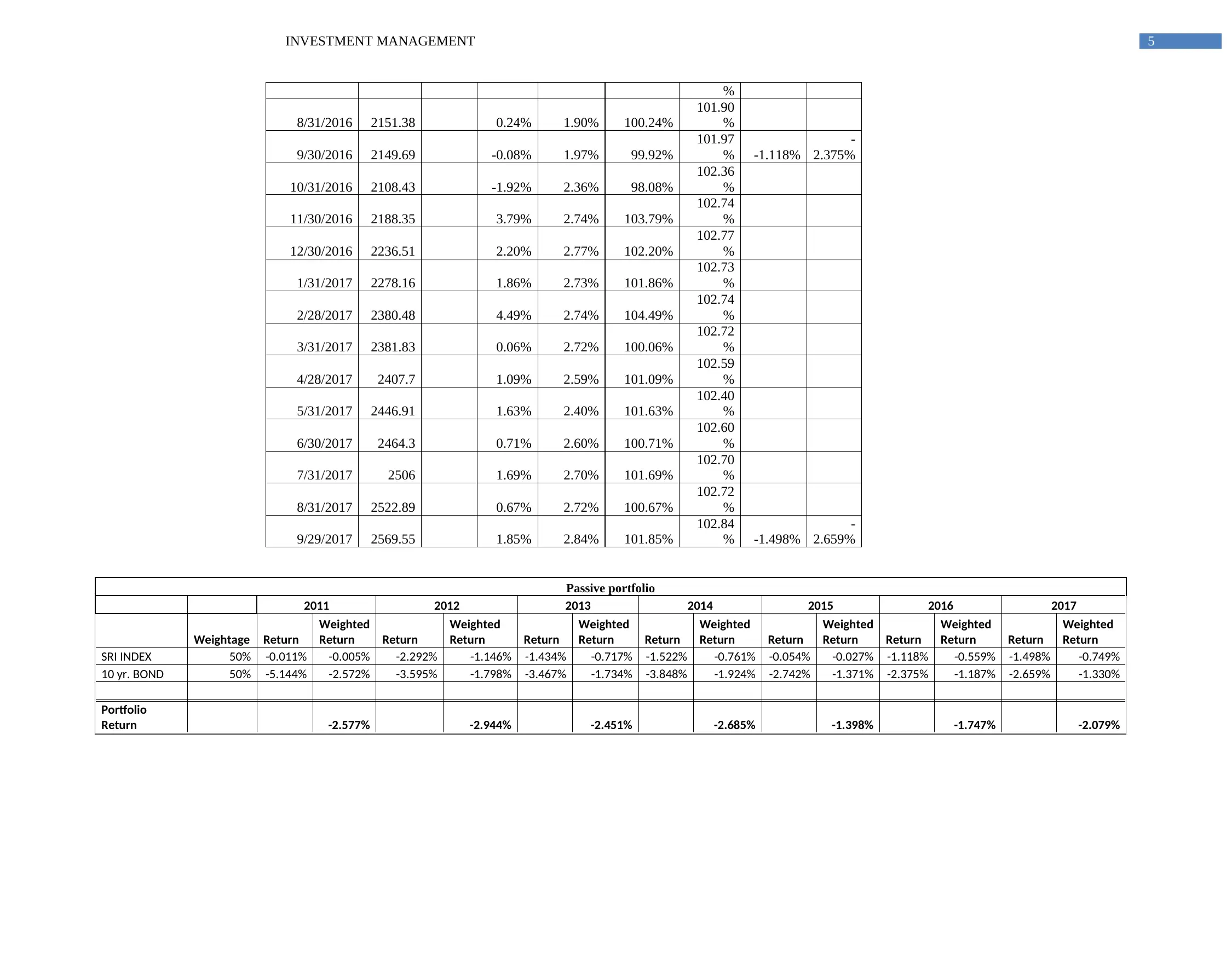
5INVESTMENT MANAGEMENT
%
8/31/2016 2151.38 0.24% 1.90% 100.24%
101.90
%
9/30/2016 2149.69 -0.08% 1.97% 99.92%
101.97
% -1.118%
-
2.375%
10/31/2016 2108.43 -1.92% 2.36% 98.08%
102.36
%
11/30/2016 2188.35 3.79% 2.74% 103.79%
102.74
%
12/30/2016 2236.51 2.20% 2.77% 102.20%
102.77
%
1/31/2017 2278.16 1.86% 2.73% 101.86%
102.73
%
2/28/2017 2380.48 4.49% 2.74% 104.49%
102.74
%
3/31/2017 2381.83 0.06% 2.72% 100.06%
102.72
%
4/28/2017 2407.7 1.09% 2.59% 101.09%
102.59
%
5/31/2017 2446.91 1.63% 2.40% 101.63%
102.40
%
6/30/2017 2464.3 0.71% 2.60% 100.71%
102.60
%
7/31/2017 2506 1.69% 2.70% 101.69%
102.70
%
8/31/2017 2522.89 0.67% 2.72% 100.67%
102.72
%
9/29/2017 2569.55 1.85% 2.84% 101.85%
102.84
% -1.498%
-
2.659%
Passive portfolio
2011 2012 2013 2014 2015 2016 2017
Weightage Return
Weighted
Return Return
Weighted
Return Return
Weighted
Return Return
Weighted
Return Return
Weighted
Return Return
Weighted
Return Return
Weighted
Return
SRI INDEX 50% -0.011% -0.005% -2.292% -1.146% -1.434% -0.717% -1.522% -0.761% -0.054% -0.027% -1.118% -0.559% -1.498% -0.749%
10 yr. BOND 50% -5.144% -2.572% -3.595% -1.798% -3.467% -1.734% -3.848% -1.924% -2.742% -1.371% -2.375% -1.187% -2.659% -1.330%
Portfolio
Return -2.577% -2.944% -2.451% -2.685% -1.398% -1.747% -2.079%
%
8/31/2016 2151.38 0.24% 1.90% 100.24%
101.90
%
9/30/2016 2149.69 -0.08% 1.97% 99.92%
101.97
% -1.118%
-
2.375%
10/31/2016 2108.43 -1.92% 2.36% 98.08%
102.36
%
11/30/2016 2188.35 3.79% 2.74% 103.79%
102.74
%
12/30/2016 2236.51 2.20% 2.77% 102.20%
102.77
%
1/31/2017 2278.16 1.86% 2.73% 101.86%
102.73
%
2/28/2017 2380.48 4.49% 2.74% 104.49%
102.74
%
3/31/2017 2381.83 0.06% 2.72% 100.06%
102.72
%
4/28/2017 2407.7 1.09% 2.59% 101.09%
102.59
%
5/31/2017 2446.91 1.63% 2.40% 101.63%
102.40
%
6/30/2017 2464.3 0.71% 2.60% 100.71%
102.60
%
7/31/2017 2506 1.69% 2.70% 101.69%
102.70
%
8/31/2017 2522.89 0.67% 2.72% 100.67%
102.72
%
9/29/2017 2569.55 1.85% 2.84% 101.85%
102.84
% -1.498%
-
2.659%
Passive portfolio
2011 2012 2013 2014 2015 2016 2017
Weightage Return
Weighted
Return Return
Weighted
Return Return
Weighted
Return Return
Weighted
Return Return
Weighted
Return Return
Weighted
Return Return
Weighted
Return
SRI INDEX 50% -0.011% -0.005% -2.292% -1.146% -1.434% -0.717% -1.522% -0.761% -0.054% -0.027% -1.118% -0.559% -1.498% -0.749%
10 yr. BOND 50% -5.144% -2.572% -3.595% -1.798% -3.467% -1.734% -3.848% -1.924% -2.742% -1.371% -2.375% -1.187% -2.659% -1.330%
Portfolio
Return -2.577% -2.944% -2.451% -2.685% -1.398% -1.747% -2.079%
Paraphrase This Document
Need a fresh take? Get an instant paraphrase of this document with our AI Paraphraser
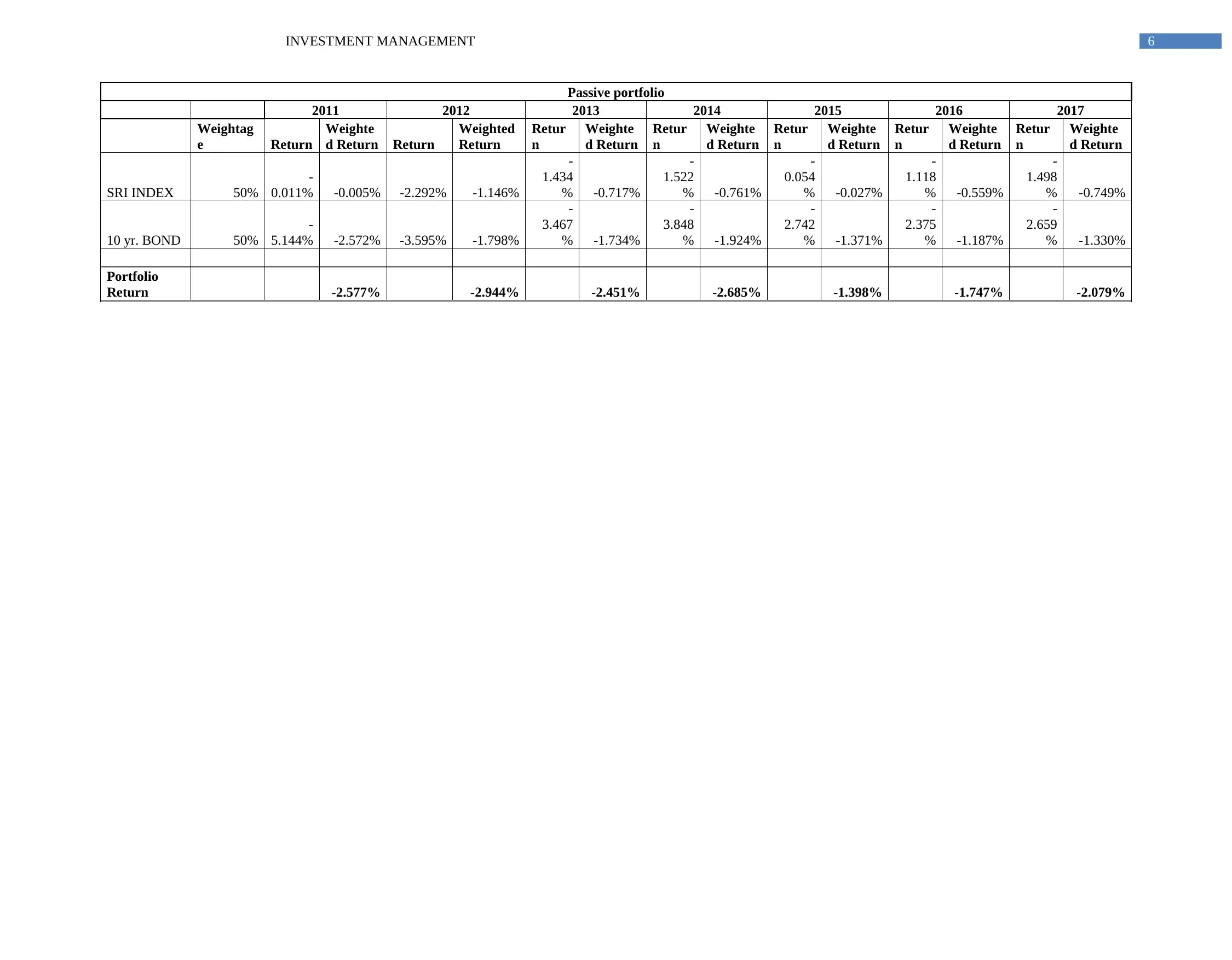
6INVESTMENT MANAGEMENT
Passive portfolio
2011 2012 2013 2014 2015 2016 2017
Weightag
e Return
Weighte
d Return Return
Weighted
Return
Retur
n
Weighte
d Return
Retur
n
Weighte
d Return
Retur
n
Weighte
d Return
Retur
n
Weighte
d Return
Retur
n
Weighte
d Return
SRI INDEX 50%
-
0.011% -0.005% -2.292% -1.146%
-
1.434
% -0.717%
-
1.522
% -0.761%
-
0.054
% -0.027%
-
1.118
% -0.559%
-
1.498
% -0.749%
10 yr. BOND 50%
-
5.144% -2.572% -3.595% -1.798%
-
3.467
% -1.734%
-
3.848
% -1.924%
-
2.742
% -1.371%
-
2.375
% -1.187%
-
2.659
% -1.330%
Portfolio
Return -2.577% -2.944% -2.451% -2.685% -1.398% -1.747% -2.079%
Passive portfolio
2011 2012 2013 2014 2015 2016 2017
Weightag
e Return
Weighte
d Return Return
Weighted
Return
Retur
n
Weighte
d Return
Retur
n
Weighte
d Return
Retur
n
Weighte
d Return
Retur
n
Weighte
d Return
Retur
n
Weighte
d Return
SRI INDEX 50%
-
0.011% -0.005% -2.292% -1.146%
-
1.434
% -0.717%
-
1.522
% -0.761%
-
0.054
% -0.027%
-
1.118
% -0.559%
-
1.498
% -0.749%
10 yr. BOND 50%
-
5.144% -2.572% -3.595% -1.798%
-
3.467
% -1.734%
-
3.848
% -1.924%
-
2.742
% -1.371%
-
2.375
% -1.187%
-
2.659
% -1.330%
Portfolio
Return -2.577% -2.944% -2.451% -2.685% -1.398% -1.747% -2.079%
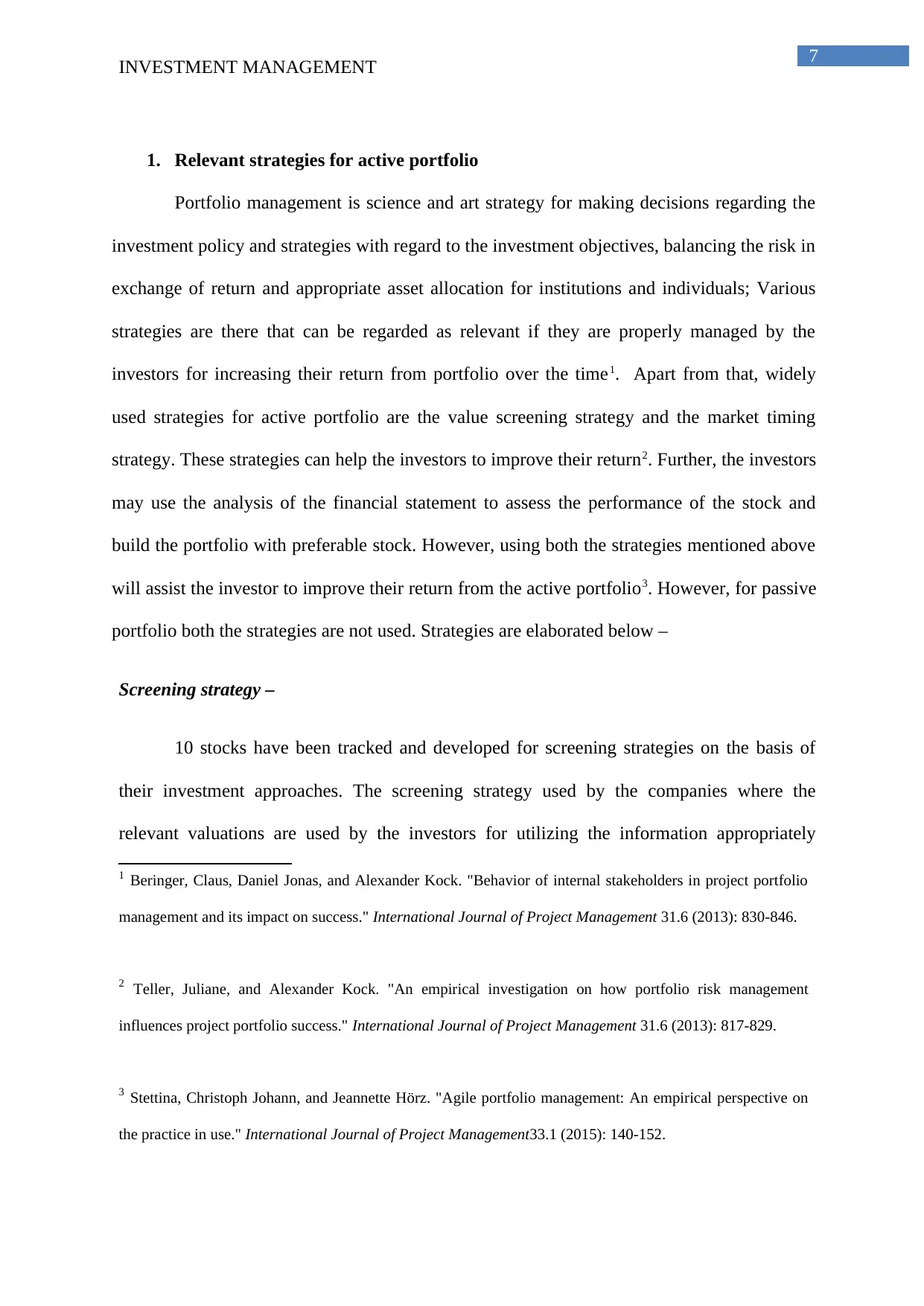
7
INVESTMENT MANAGEMENT
1. Relevant strategies for active portfolio
Portfolio management is science and art strategy for making decisions regarding the
investment policy and strategies with regard to the investment objectives, balancing the risk in
exchange of return and appropriate asset allocation for institutions and individuals; Various
strategies are there that can be regarded as relevant if they are properly managed by the
investors for increasing their return from portfolio over the time1. Apart from that, widely
used strategies for active portfolio are the value screening strategy and the market timing
strategy. These strategies can help the investors to improve their return2. Further, the investors
may use the analysis of the financial statement to assess the performance of the stock and
build the portfolio with preferable stock. However, using both the strategies mentioned above
will assist the investor to improve their return from the active portfolio3. However, for passive
portfolio both the strategies are not used. Strategies are elaborated below –
Screening strategy –
10 stocks have been tracked and developed for screening strategies on the basis of
their investment approaches. The screening strategy used by the companies where the
relevant valuations are used by the investors for utilizing the information appropriately
1 Beringer, Claus, Daniel Jonas, and Alexander Kock. "Behavior of internal stakeholders in project portfolio
management and its impact on success." International Journal of Project Management 31.6 (2013): 830-846.
2 Teller, Juliane, and Alexander Kock. "An empirical investigation on how portfolio risk management
influences project portfolio success." International Journal of Project Management 31.6 (2013): 817-829.
3 Stettina, Christoph Johann, and Jeannette Hörz. "Agile portfolio management: An empirical perspective on
the practice in use." International Journal of Project Management33.1 (2015): 140-152.
INVESTMENT MANAGEMENT
1. Relevant strategies for active portfolio
Portfolio management is science and art strategy for making decisions regarding the
investment policy and strategies with regard to the investment objectives, balancing the risk in
exchange of return and appropriate asset allocation for institutions and individuals; Various
strategies are there that can be regarded as relevant if they are properly managed by the
investors for increasing their return from portfolio over the time1. Apart from that, widely
used strategies for active portfolio are the value screening strategy and the market timing
strategy. These strategies can help the investors to improve their return2. Further, the investors
may use the analysis of the financial statement to assess the performance of the stock and
build the portfolio with preferable stock. However, using both the strategies mentioned above
will assist the investor to improve their return from the active portfolio3. However, for passive
portfolio both the strategies are not used. Strategies are elaborated below –
Screening strategy –
10 stocks have been tracked and developed for screening strategies on the basis of
their investment approaches. The screening strategy used by the companies where the
relevant valuations are used by the investors for utilizing the information appropriately
1 Beringer, Claus, Daniel Jonas, and Alexander Kock. "Behavior of internal stakeholders in project portfolio
management and its impact on success." International Journal of Project Management 31.6 (2013): 830-846.
2 Teller, Juliane, and Alexander Kock. "An empirical investigation on how portfolio risk management
influences project portfolio success." International Journal of Project Management 31.6 (2013): 817-829.
3 Stettina, Christoph Johann, and Jeannette Hörz. "Agile portfolio management: An empirical perspective on
the practice in use." International Journal of Project Management33.1 (2015): 140-152.
⊘ This is a preview!⊘
Do you want full access?
Subscribe today to unlock all pages.

Trusted by 1+ million students worldwide

8INVESTMENT MANAGEMENT
derived from the stock to improve the return. The screening strategy takes into consideration
various factors like dividend income, P/E ratio, return on assets and return on equity,
associated risks for evaluating the stock. The strategy also helps to recognize the investment
opportunities, standard deviation that is risks of the stock to find out the ways for improve
the return. This strategy is popular with the investors as it can assist in creating the
appropriate portfolio that will give maximum return with minimum risk.
Marketing timing strategy –
Market timing is the strategy used by investors under which he tries to recognize best
times to enter the market and get out of the market depending on the market analysis and
forecasts; the market timing is generally used by the financial analysts, brokers and the
managers for portfolio for reaping the highest return for their clients4. Proper timing requires
investors to assess when to enter 100% in the market and when to out 100% from 1 out of 3
classes of assets that are the money markets, bonds and stocks. Further, with the help of
marketing strategies the investors can decide regarding the movement of assets from the
weights of portfolio. Further, on the basis of expected movement of market and the
probability of the return against risk, return can be assessed for each class of assets 5.
4 Pinto, Jeffrey K. Project management: achieving competitive advantage. Prentice Hall, 2015.
5 Jonas, Daniel, Alexander Kock, and Hans Georg Gemünden. "Predicting project portfolio success by
measuring management quality—a longitudinal study." IEEE Transactions on Engineering Management 60.2
(2013): 215-226.
derived from the stock to improve the return. The screening strategy takes into consideration
various factors like dividend income, P/E ratio, return on assets and return on equity,
associated risks for evaluating the stock. The strategy also helps to recognize the investment
opportunities, standard deviation that is risks of the stock to find out the ways for improve
the return. This strategy is popular with the investors as it can assist in creating the
appropriate portfolio that will give maximum return with minimum risk.
Marketing timing strategy –
Market timing is the strategy used by investors under which he tries to recognize best
times to enter the market and get out of the market depending on the market analysis and
forecasts; the market timing is generally used by the financial analysts, brokers and the
managers for portfolio for reaping the highest return for their clients4. Proper timing requires
investors to assess when to enter 100% in the market and when to out 100% from 1 out of 3
classes of assets that are the money markets, bonds and stocks. Further, with the help of
marketing strategies the investors can decide regarding the movement of assets from the
weights of portfolio. Further, on the basis of expected movement of market and the
probability of the return against risk, return can be assessed for each class of assets 5.
4 Pinto, Jeffrey K. Project management: achieving competitive advantage. Prentice Hall, 2015.
5 Jonas, Daniel, Alexander Kock, and Hans Georg Gemünden. "Predicting project portfolio success by
measuring management quality—a longitudinal study." IEEE Transactions on Engineering Management 60.2
(2013): 215-226.
Paraphrase This Document
Need a fresh take? Get an instant paraphrase of this document with our AI Paraphraser
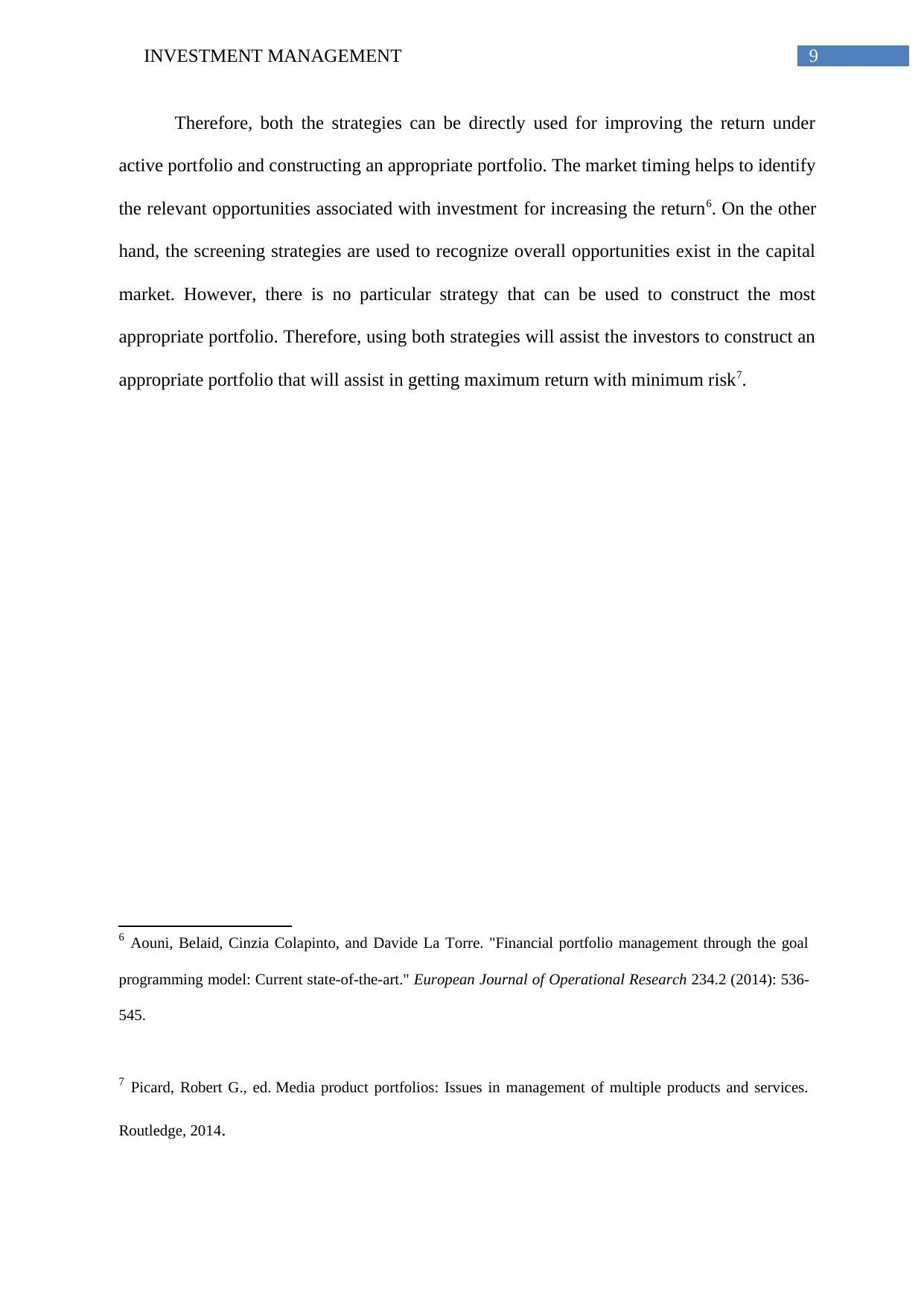
9INVESTMENT MANAGEMENT
Therefore, both the strategies can be directly used for improving the return under
active portfolio and constructing an appropriate portfolio. The market timing helps to identify
the relevant opportunities associated with investment for increasing the return6. On the other
hand, the screening strategies are used to recognize overall opportunities exist in the capital
market. However, there is no particular strategy that can be used to construct the most
appropriate portfolio. Therefore, using both strategies will assist the investors to construct an
appropriate portfolio that will assist in getting maximum return with minimum risk7.
6 Aouni, Belaid, Cinzia Colapinto, and Davide La Torre. "Financial portfolio management through the goal
programming model: Current state-of-the-art." European Journal of Operational Research 234.2 (2014): 536-
545.
7 Picard, Robert G., ed. Media product portfolios: Issues in management of multiple products and services.
Routledge, 2014.
Therefore, both the strategies can be directly used for improving the return under
active portfolio and constructing an appropriate portfolio. The market timing helps to identify
the relevant opportunities associated with investment for increasing the return6. On the other
hand, the screening strategies are used to recognize overall opportunities exist in the capital
market. However, there is no particular strategy that can be used to construct the most
appropriate portfolio. Therefore, using both strategies will assist the investors to construct an
appropriate portfolio that will assist in getting maximum return with minimum risk7.
6 Aouni, Belaid, Cinzia Colapinto, and Davide La Torre. "Financial portfolio management through the goal
programming model: Current state-of-the-art." European Journal of Operational Research 234.2 (2014): 536-
545.
7 Picard, Robert G., ed. Media product portfolios: Issues in management of multiple products and services.
Routledge, 2014.
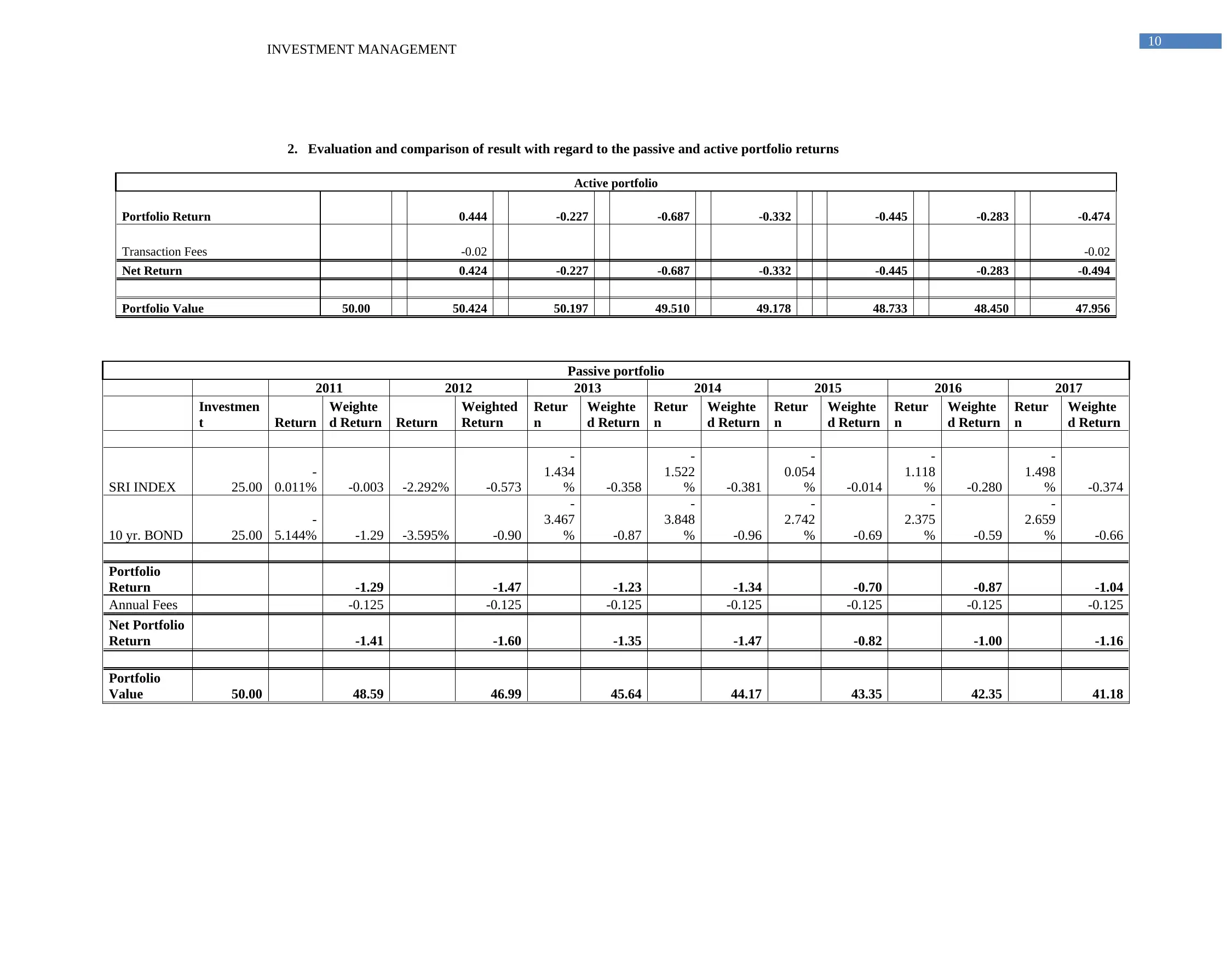
10
INVESTMENT MANAGEMENT
2. Evaluation and comparison of result with regard to the passive and active portfolio returns
Active portfolio
Portfolio Return 0.444 -0.227 -0.687 -0.332 -0.445 -0.283 -0.474
Transaction Fees -0.02 -0.02
Net Return 0.424 -0.227 -0.687 -0.332 -0.445 -0.283 -0.494
Portfolio Value 50.00 50.424 50.197 49.510 49.178 48.733 48.450 47.956
Passive portfolio
2011 2012 2013 2014 2015 2016 2017
Investmen
t Return
Weighte
d Return Return
Weighted
Return
Retur
n
Weighte
d Return
Retur
n
Weighte
d Return
Retur
n
Weighte
d Return
Retur
n
Weighte
d Return
Retur
n
Weighte
d Return
SRI INDEX 25.00
-
0.011% -0.003 -2.292% -0.573
-
1.434
% -0.358
-
1.522
% -0.381
-
0.054
% -0.014
-
1.118
% -0.280
-
1.498
% -0.374
10 yr. BOND 25.00
-
5.144% -1.29 -3.595% -0.90
-
3.467
% -0.87
-
3.848
% -0.96
-
2.742
% -0.69
-
2.375
% -0.59
-
2.659
% -0.66
Portfolio
Return -1.29 -1.47 -1.23 -1.34 -0.70 -0.87 -1.04
Annual Fees -0.125 -0.125 -0.125 -0.125 -0.125 -0.125 -0.125
Net Portfolio
Return -1.41 -1.60 -1.35 -1.47 -0.82 -1.00 -1.16
Portfolio
Value 50.00 48.59 46.99 45.64 44.17 43.35 42.35 41.18
INVESTMENT MANAGEMENT
2. Evaluation and comparison of result with regard to the passive and active portfolio returns
Active portfolio
Portfolio Return 0.444 -0.227 -0.687 -0.332 -0.445 -0.283 -0.474
Transaction Fees -0.02 -0.02
Net Return 0.424 -0.227 -0.687 -0.332 -0.445 -0.283 -0.494
Portfolio Value 50.00 50.424 50.197 49.510 49.178 48.733 48.450 47.956
Passive portfolio
2011 2012 2013 2014 2015 2016 2017
Investmen
t Return
Weighte
d Return Return
Weighted
Return
Retur
n
Weighte
d Return
Retur
n
Weighte
d Return
Retur
n
Weighte
d Return
Retur
n
Weighte
d Return
Retur
n
Weighte
d Return
SRI INDEX 25.00
-
0.011% -0.003 -2.292% -0.573
-
1.434
% -0.358
-
1.522
% -0.381
-
0.054
% -0.014
-
1.118
% -0.280
-
1.498
% -0.374
10 yr. BOND 25.00
-
5.144% -1.29 -3.595% -0.90
-
3.467
% -0.87
-
3.848
% -0.96
-
2.742
% -0.69
-
2.375
% -0.59
-
2.659
% -0.66
Portfolio
Return -1.29 -1.47 -1.23 -1.34 -0.70 -0.87 -1.04
Annual Fees -0.125 -0.125 -0.125 -0.125 -0.125 -0.125 -0.125
Net Portfolio
Return -1.41 -1.60 -1.35 -1.47 -0.82 -1.00 -1.16
Portfolio
Value 50.00 48.59 46.99 45.64 44.17 43.35 42.35 41.18
⊘ This is a preview!⊘
Do you want full access?
Subscribe today to unlock all pages.

Trusted by 1+ million students worldwide
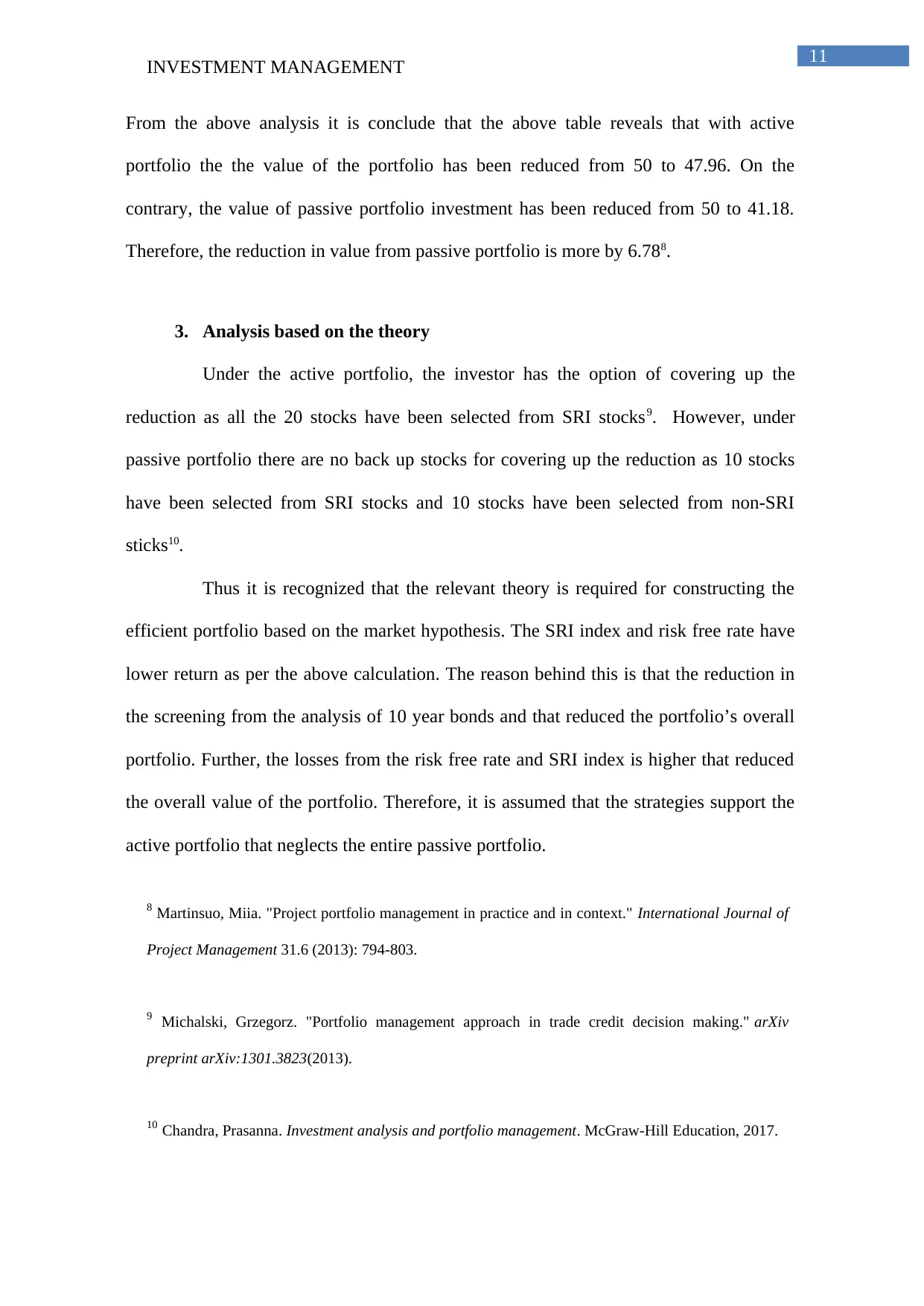
11
INVESTMENT MANAGEMENT
From the above analysis it is conclude that the above table reveals that with active
portfolio the the value of the portfolio has been reduced from 50 to 47.96. On the
contrary, the value of passive portfolio investment has been reduced from 50 to 41.18.
Therefore, the reduction in value from passive portfolio is more by 6.788.
3. Analysis based on the theory
Under the active portfolio, the investor has the option of covering up the
reduction as all the 20 stocks have been selected from SRI stocks9. However, under
passive portfolio there are no back up stocks for covering up the reduction as 10 stocks
have been selected from SRI stocks and 10 stocks have been selected from non-SRI
sticks10.
Thus it is recognized that the relevant theory is required for constructing the
efficient portfolio based on the market hypothesis. The SRI index and risk free rate have
lower return as per the above calculation. The reason behind this is that the reduction in
the screening from the analysis of 10 year bonds and that reduced the portfolio’s overall
portfolio. Further, the losses from the risk free rate and SRI index is higher that reduced
the overall value of the portfolio. Therefore, it is assumed that the strategies support the
active portfolio that neglects the entire passive portfolio.
8 Martinsuo, Miia. "Project portfolio management in practice and in context." International Journal of
Project Management 31.6 (2013): 794-803.
9 Michalski, Grzegorz. "Portfolio management approach in trade credit decision making." arXiv
preprint arXiv:1301.3823(2013).
10 Chandra, Prasanna. Investment analysis and portfolio management. McGraw-Hill Education, 2017.
INVESTMENT MANAGEMENT
From the above analysis it is conclude that the above table reveals that with active
portfolio the the value of the portfolio has been reduced from 50 to 47.96. On the
contrary, the value of passive portfolio investment has been reduced from 50 to 41.18.
Therefore, the reduction in value from passive portfolio is more by 6.788.
3. Analysis based on the theory
Under the active portfolio, the investor has the option of covering up the
reduction as all the 20 stocks have been selected from SRI stocks9. However, under
passive portfolio there are no back up stocks for covering up the reduction as 10 stocks
have been selected from SRI stocks and 10 stocks have been selected from non-SRI
sticks10.
Thus it is recognized that the relevant theory is required for constructing the
efficient portfolio based on the market hypothesis. The SRI index and risk free rate have
lower return as per the above calculation. The reason behind this is that the reduction in
the screening from the analysis of 10 year bonds and that reduced the portfolio’s overall
portfolio. Further, the losses from the risk free rate and SRI index is higher that reduced
the overall value of the portfolio. Therefore, it is assumed that the strategies support the
active portfolio that neglects the entire passive portfolio.
8 Martinsuo, Miia. "Project portfolio management in practice and in context." International Journal of
Project Management 31.6 (2013): 794-803.
9 Michalski, Grzegorz. "Portfolio management approach in trade credit decision making." arXiv
preprint arXiv:1301.3823(2013).
10 Chandra, Prasanna. Investment analysis and portfolio management. McGraw-Hill Education, 2017.
Paraphrase This Document
Need a fresh take? Get an instant paraphrase of this document with our AI Paraphraser

12INVESTMENT MANAGEMENT
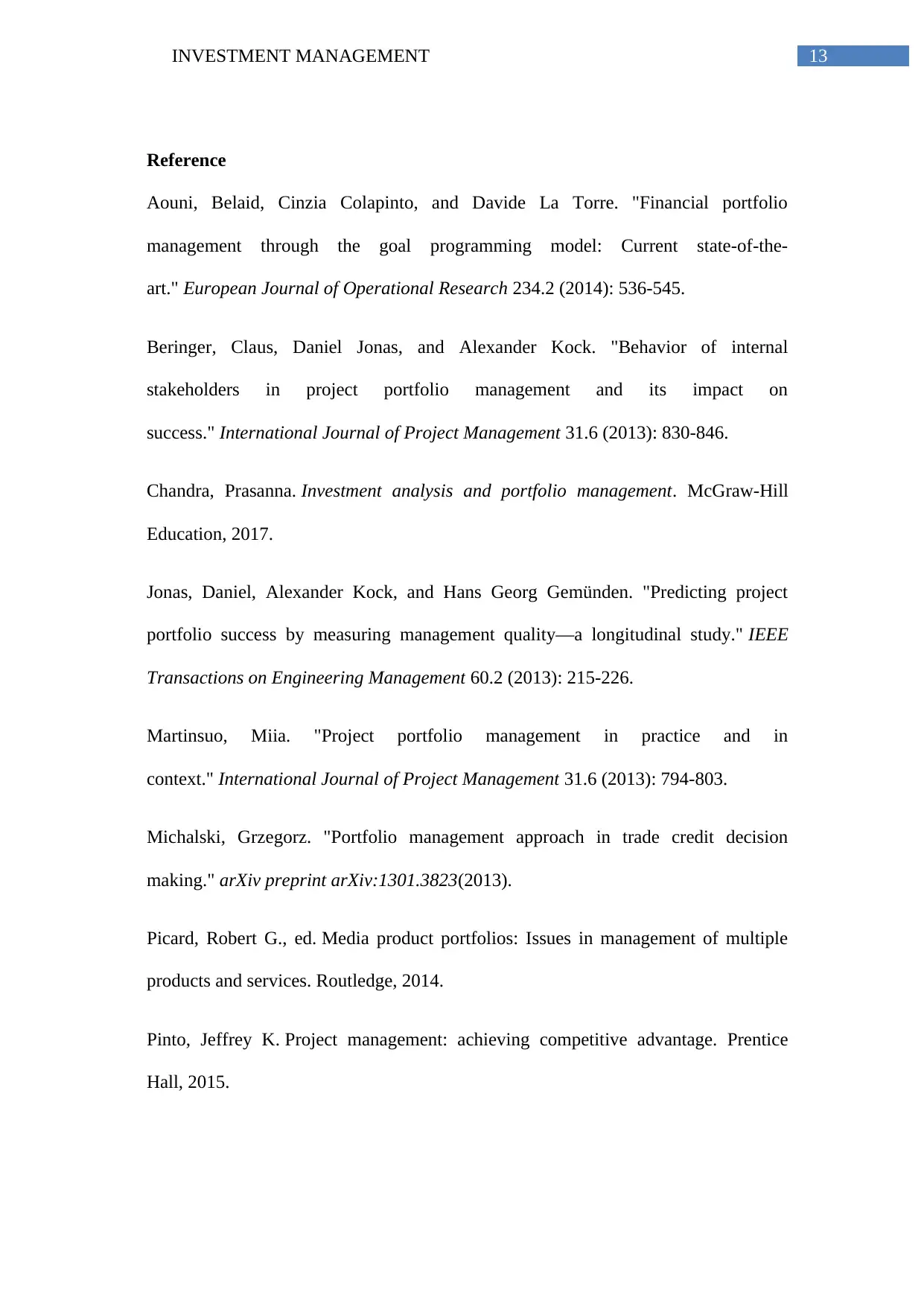
13INVESTMENT MANAGEMENT
Reference
Aouni, Belaid, Cinzia Colapinto, and Davide La Torre. "Financial portfolio
management through the goal programming model: Current state-of-the-
art." European Journal of Operational Research 234.2 (2014): 536-545.
Beringer, Claus, Daniel Jonas, and Alexander Kock. "Behavior of internal
stakeholders in project portfolio management and its impact on
success." International Journal of Project Management 31.6 (2013): 830-846.
Chandra, Prasanna. Investment analysis and portfolio management. McGraw-Hill
Education, 2017.
Jonas, Daniel, Alexander Kock, and Hans Georg Gemünden. "Predicting project
portfolio success by measuring management quality—a longitudinal study." IEEE
Transactions on Engineering Management 60.2 (2013): 215-226.
Martinsuo, Miia. "Project portfolio management in practice and in
context." International Journal of Project Management 31.6 (2013): 794-803.
Michalski, Grzegorz. "Portfolio management approach in trade credit decision
making." arXiv preprint arXiv:1301.3823(2013).
Picard, Robert G., ed. Media product portfolios: Issues in management of multiple
products and services. Routledge, 2014.
Pinto, Jeffrey K. Project management: achieving competitive advantage. Prentice
Hall, 2015.
Reference
Aouni, Belaid, Cinzia Colapinto, and Davide La Torre. "Financial portfolio
management through the goal programming model: Current state-of-the-
art." European Journal of Operational Research 234.2 (2014): 536-545.
Beringer, Claus, Daniel Jonas, and Alexander Kock. "Behavior of internal
stakeholders in project portfolio management and its impact on
success." International Journal of Project Management 31.6 (2013): 830-846.
Chandra, Prasanna. Investment analysis and portfolio management. McGraw-Hill
Education, 2017.
Jonas, Daniel, Alexander Kock, and Hans Georg Gemünden. "Predicting project
portfolio success by measuring management quality—a longitudinal study." IEEE
Transactions on Engineering Management 60.2 (2013): 215-226.
Martinsuo, Miia. "Project portfolio management in practice and in
context." International Journal of Project Management 31.6 (2013): 794-803.
Michalski, Grzegorz. "Portfolio management approach in trade credit decision
making." arXiv preprint arXiv:1301.3823(2013).
Picard, Robert G., ed. Media product portfolios: Issues in management of multiple
products and services. Routledge, 2014.
Pinto, Jeffrey K. Project management: achieving competitive advantage. Prentice
Hall, 2015.
⊘ This is a preview!⊘
Do you want full access?
Subscribe today to unlock all pages.

Trusted by 1+ million students worldwide
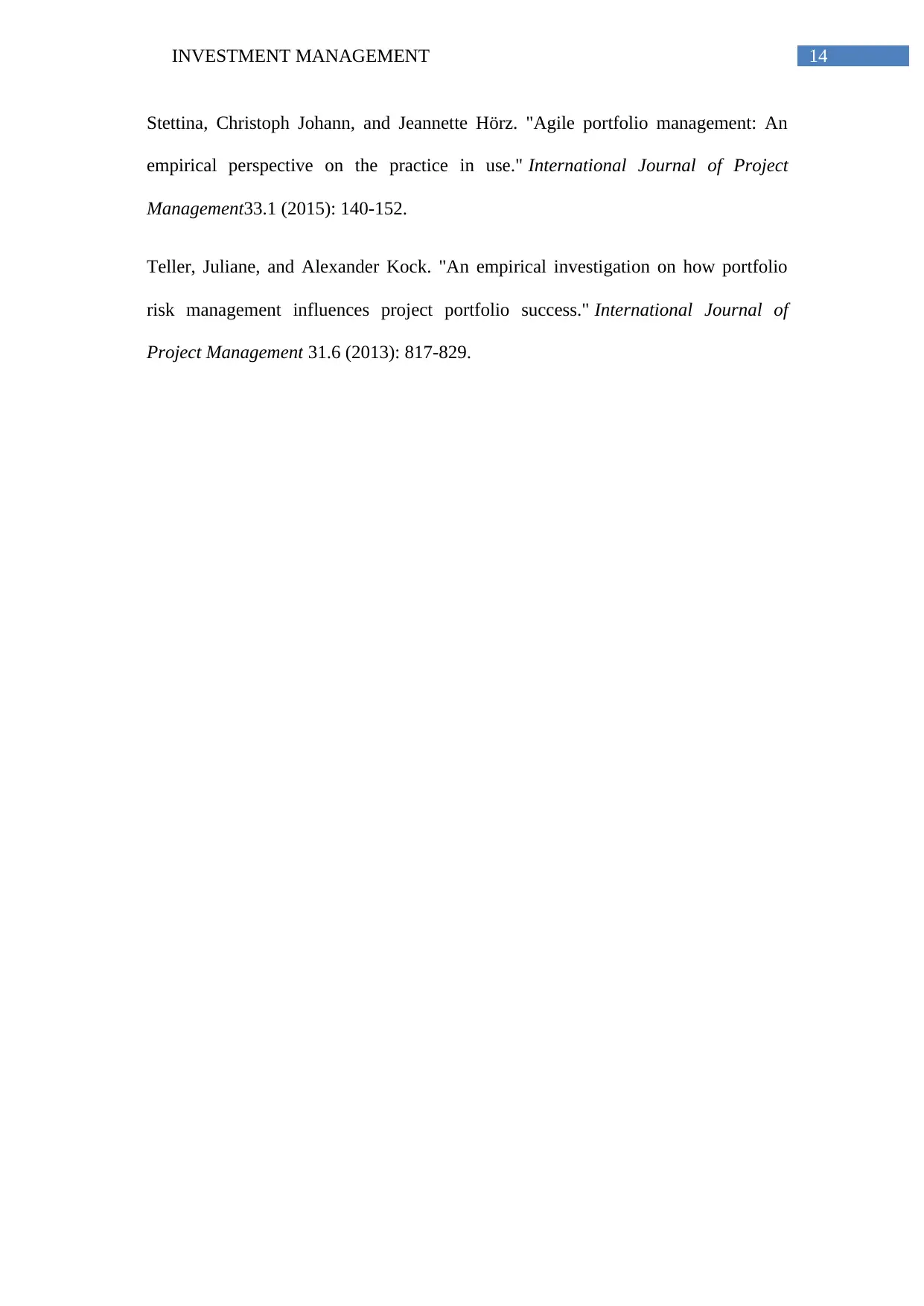
14INVESTMENT MANAGEMENT
Stettina, Christoph Johann, and Jeannette Hörz. "Agile portfolio management: An
empirical perspective on the practice in use." International Journal of Project
Management33.1 (2015): 140-152.
Teller, Juliane, and Alexander Kock. "An empirical investigation on how portfolio
risk management influences project portfolio success." International Journal of
Project Management 31.6 (2013): 817-829.
Stettina, Christoph Johann, and Jeannette Hörz. "Agile portfolio management: An
empirical perspective on the practice in use." International Journal of Project
Management33.1 (2015): 140-152.
Teller, Juliane, and Alexander Kock. "An empirical investigation on how portfolio
risk management influences project portfolio success." International Journal of
Project Management 31.6 (2013): 817-829.
1 out of 16
Your All-in-One AI-Powered Toolkit for Academic Success.
+13062052269
info@desklib.com
Available 24*7 on WhatsApp / Email
![[object Object]](/_next/static/media/star-bottom.7253800d.svg)
Unlock your academic potential
© 2024 | Zucol Services PVT LTD | All rights reserved.